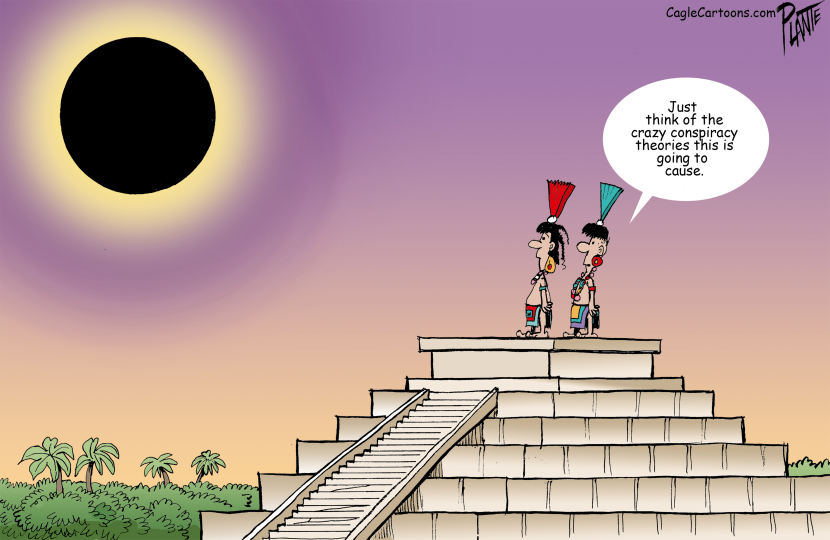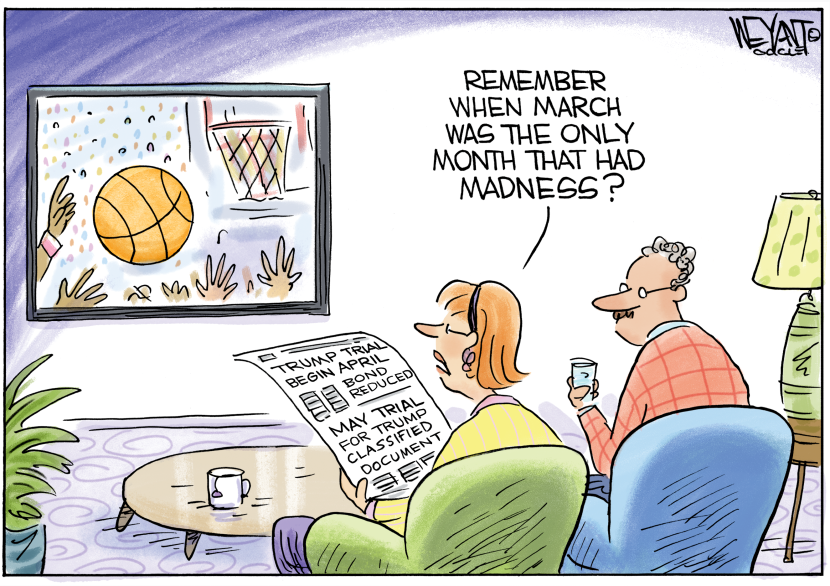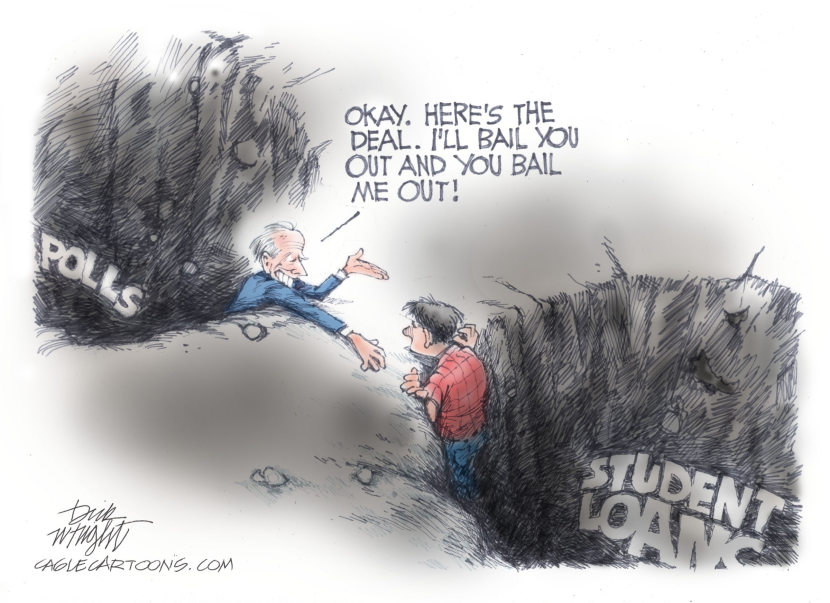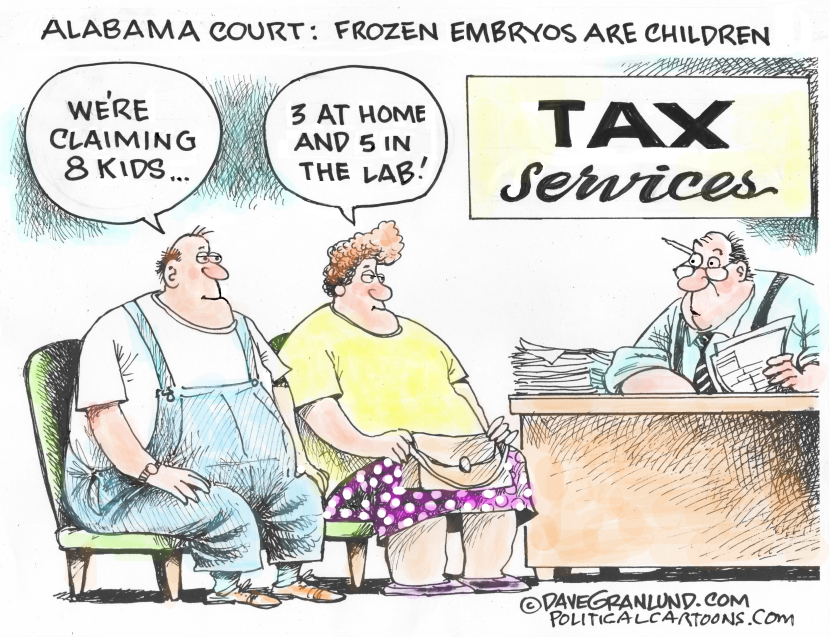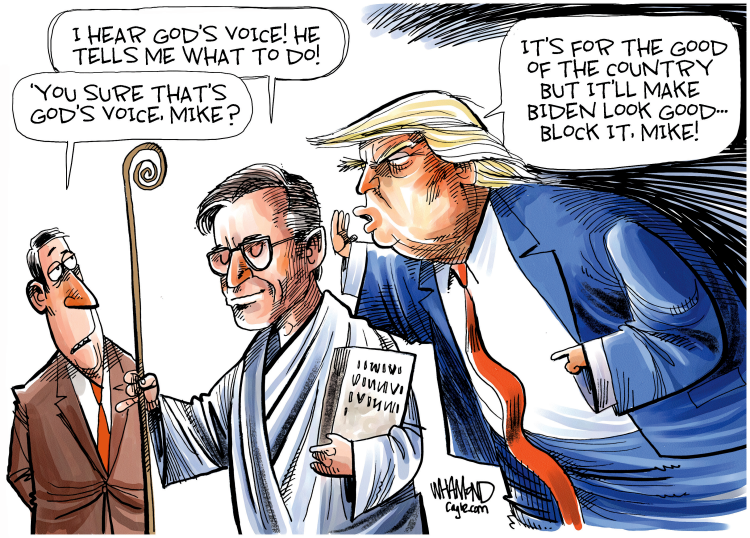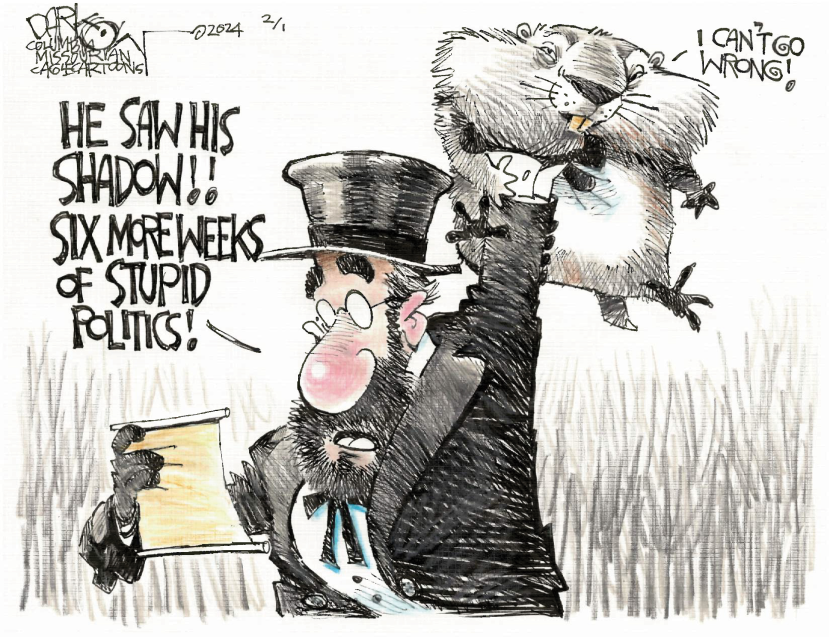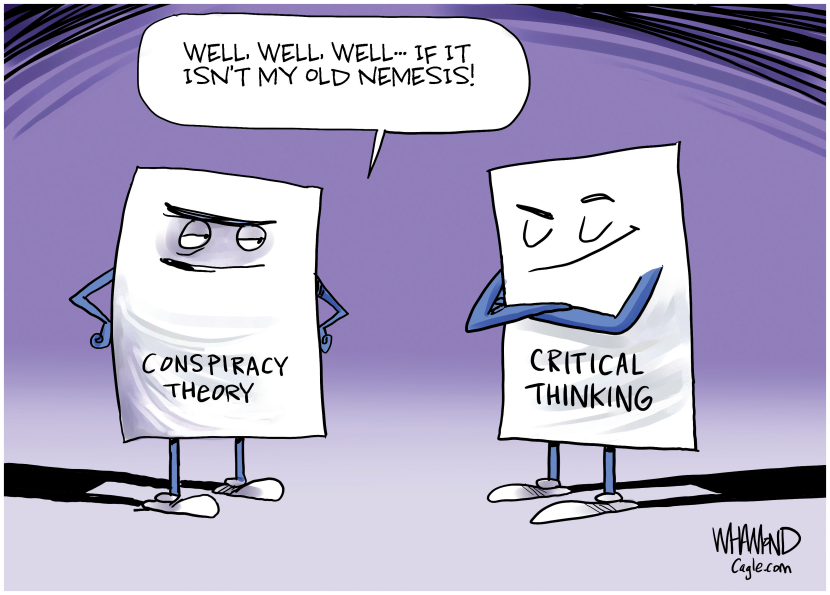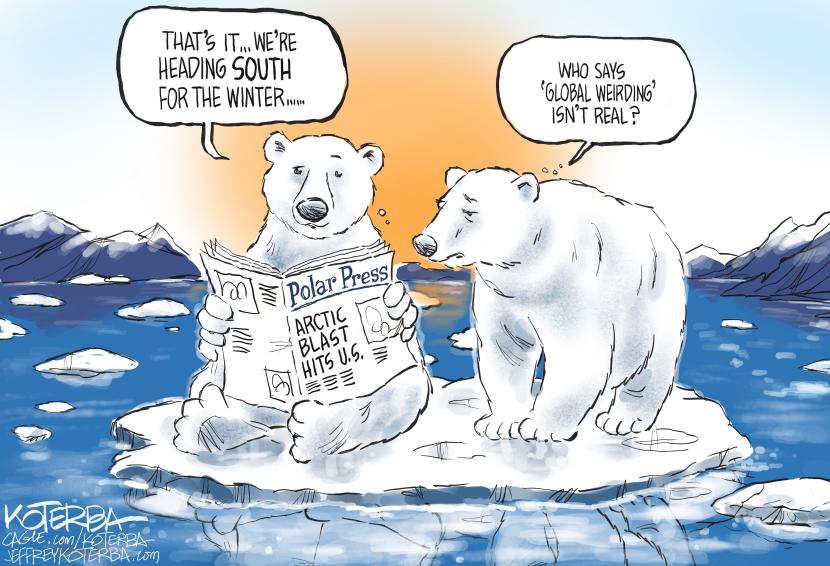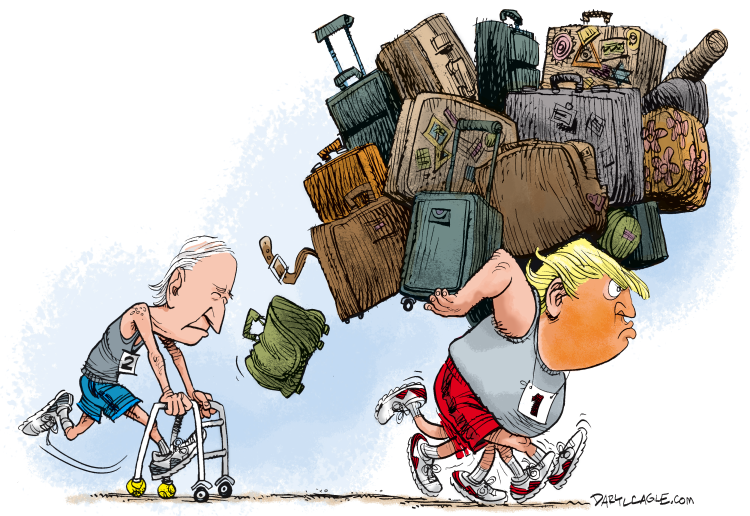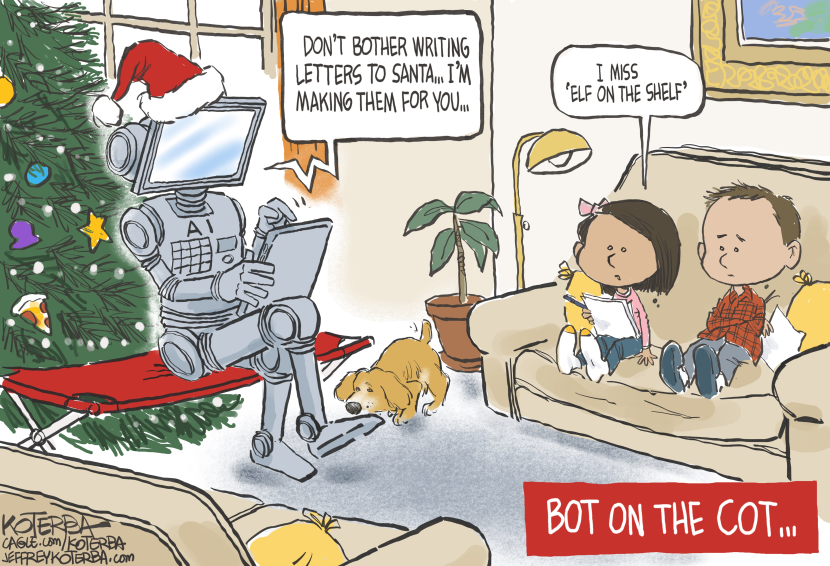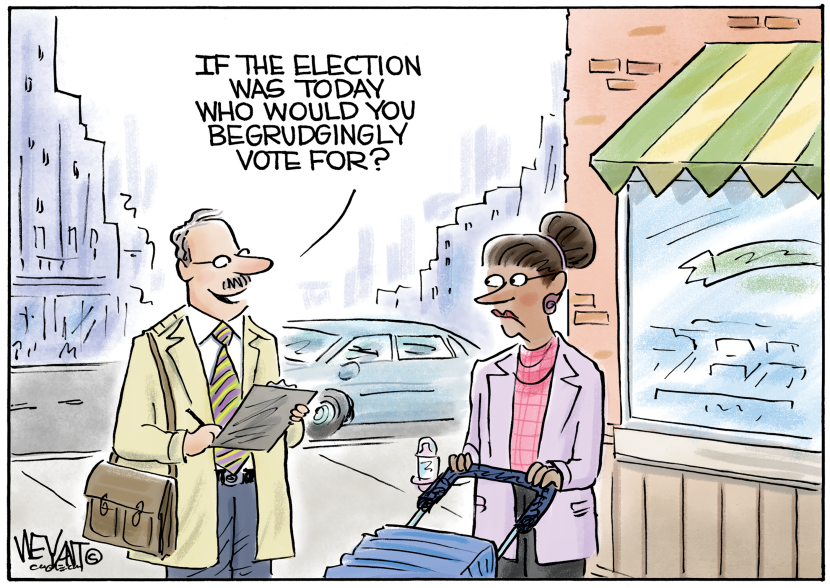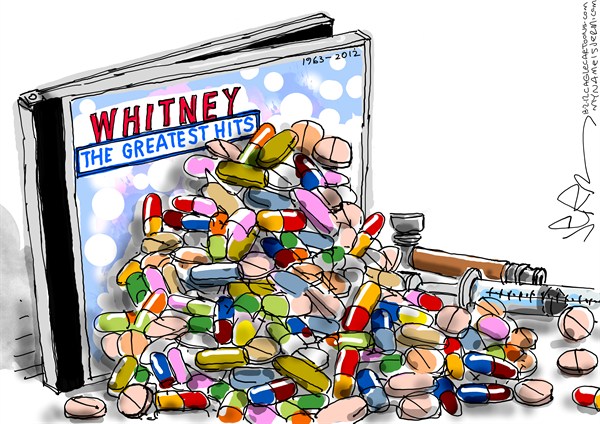It’s an understatement to say that the events of September 11 will forever be etched in the minds of millions of Americans. As we commemorate the 10th anniversary of that tragic day, I thought it would be good to ask some of the top political cartoonists to reflect on that day and how it affected their creative process.
As cartoonists are masters at combining words and symbols into one single, powerful image in a small space, it’s an interesting look back at a day none of us will ever forget.

Mike Keefe, Denver Post
On September 11, 2001, as I walked into the service department waiting room at the Empire Nissan dealership in Lakewood, Colorado, five or six people were glued to the TV set on the wall. One woman had her hand clamped across her mouth. On the screen was the image of one of the Twin Towers in smoke and flames.
An elderly man told me a jet liner had crashed in to the skyscraper.
I called my wife and told her to turn on the television. I hung up and a moment later another aircraft slammed into the second tower. “Holy Shit!” “What the Fuck!” Gasps filled the room.
When our shock eventually turned to silence, the same elderly man said, very quietly, “There will be war.”

Taylor Jones, Cagle Cartoons
I had just started work for the morning in my home studio on Staten Island, New York. Can’t recall if I was actually on deadline, but I might have been — for El Nuevo Día, in Puerto Rico. I was listening to NPR when they announced that a plane had crashed into the North Tower of the World Trade Center. So I switched off the radio and turned on CNN. I saw a huge hole at the top of the tower, with flames and dense smoke. Mesmerized, I watched as, a few minutes later, a second jumbo jet sliced into the South Tower. About 10 seconds later, I heard the sonic boom — the time it took for the sound of the impact to travel across New York Harbor and reach my neighborhood on Staten Island.
I worked fitfully in my studio for much of the day — an ear tuned to NPR, an eye glued to CNN or one of the network news stations. Around 10 o’clock, I drove to the local elementary school to pick up my oldest daughter from her first grade class. The principal thought all of us parents were fools to pick up our children, who were assembled in the auditorium. He was yelling at the top of his lungs, claiming that the safest place for the students to be at that moment was in school. None of the parents were buying his commentary, and, by noon, every child who could be picked up from school was safely home.
The cartoon I drew for Hoover Digest, a few weeks after the attack, was roughly based on a neighborhood in Brooklyn. I added the flags. No such “brownstone” neighborhoods exist on Staten Island. By New York City standards, Staten Island looks like suburbia, mostly. It’s the reason Staten Island is so appealing to cops and firefighters as a place to call home: A bit of green to seek respite from the brown, the fire and the smoke.
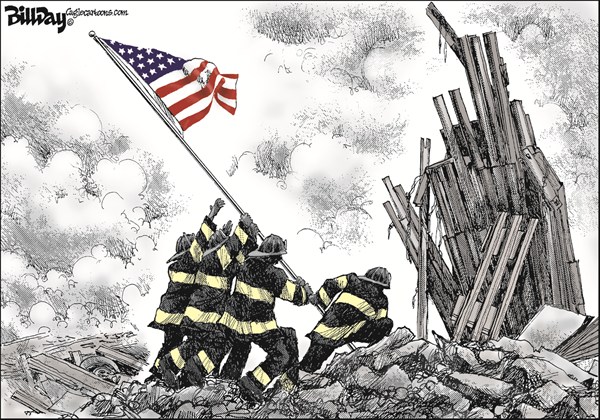
Bill Day, Cagle Cartoons
After I drew the my ‘Firemen and Flag’ cartoon, there was such an overwhelming response that the newspaper ordered shirts with the image on the back. Below the image were 3 union logos- FDNY, NYPD, and FDNY-EMS. We raised $20,000 from the sale, with newspaper staffers filling the requests and mailing them out. We divided the proceeds 3 ways and mailed it to the Union Families Fund that gave it to the families who lost loved ones in 9/11. It felt good to do something to help in some small way.

Cam Cardow, Ottawa Citizen
I had been up late the night before and so when the call from editorial page editor came at 10 a.m., I was still sleeping. She said, “Well, of course you know what topic you’re drawing today” and I responded “no.” Shocked, she asked me if I had seen the news yet and I replied I hadn’t. She said, “turn on the TV” and I asked “what channel?” “ANY channel,” she replied.
Like everyone else, my jaw dropped at the surreal images of planes hitting the towers and then she said, “I’ll need a cartoon in an hour and a half.” I knew right away it had to be a good one.
It’s amazing the things you’re capable of when adrenalin kicks in and when you have no chance to over analyze. I was pleased with my final result, given the time issues of going from concept to final drawing in 90 minutes and importance of the topic. Plus, it was the cartoon for which I was nominated for a Canadian National Newspaper Award in 2001.

Bob Englehart, Hartford Courant
I was in my studio at home working up cartoon gags for the day when my son called. “Are you watching TV?” he asked. I told him I wasn’t. He said to turn it on. “We’re being attacked.” I turned it on just in time to see the second plane hit the tower and ran downstairs to tell my wife. We watched the coverage for a few minutes and I said, “I have to go to the paper.”
I stopped for gas along the way and a customer said that the Pentagon had been hit, too. I figured it was just a rumor, but when I got to The Courant, I watched the whole 9-11 story in the newsroom. As we watched the towers collapse, I was glad I was an editorial cartoonist. At least I didn’t feel completely helpless. I could do something, but if I had been a young man, I would’ve gone out and joined the Army that day.

R.J. Matson, St. Louis Post-Dispatch
On Tuesday morning, September 11, 2011, I was in my studio in Greenwich, reading the papers, wondering what I’d draw for the New York Observer that week. The Observer hit the newsstands on Wednesday each week, and I typically faxed sketches to my editor by noon, every Tuesday, and completed the cartoon by 6pm.
I happened to be watching CNN when the first plane strike was reported and I watch the days horrifying events unfold on TV. I immediately thought of the World Trade Center bombing in 1993, which I learned about when my neighbor returned home from work mid-morning with a thick ring of black soot around his mouth. He told me about his harrowing evacuation down 80 flights in pitch black stairwells. A few days after that incident, I drew a cartoon for The Observer showing an anxious Wall Street executive at his desk on a high floor in one of the World Trade Center towers. Behind him, on the glass windows, a hammer hung by a chain and a sign read, “In Case of Emergency, Break Glass.”
I thought of that cartoon, and I wondered how people would escape the fires. I thought of my father, who ran a major company that was hired to improve the fire safety systems in the World Trade Center after 1993. The stairwells would now be lighted at least. I thought of my friends and colleagues who lived and worked downtown. I thought of my brother-in-law who was a bond trader working in one of the towers and I realized I had no idea what floor he worked on (I later learned he safety walked down about 25 flights to street level and then walked about 80 blocks north to his apartment, never looking back. He never returned to that job and moved to Denver within a week.)
I remember I was not able to reach The New York Observer by phone until late that afternoon. The Observer offices were nowhere near what we would later call Ground Zero, but I was not sure whether or not they would be able to publish that day.
Shortly after the second tower had been hit I got on my bike and rode a mile or so to a point on the Long Island Sound from which the twin towers were visible. I saw the smoke. My city had been attacked and I felt odd being thirty-five miles away. I felt I should have been there.
I returned to my studio. No word from The Observer. After the towers had collapsed, I sat stunned and absorbed the full enormity of that catastrophic day. Finally, not knowing what else to do, I started sketching and settled on this hopelessly inadequate idea which my editor saw for the first time about an hour before deadline.

Gary McCoy, Cagle Cartoons
I remember when I first heard any account of the 9/11 attacks, I was on my bedroom floor doing crunches. It was part of my morning routine before heading to work. The radio station, KMOX in St. Louis, first reported that a small bi-plane was reported to have struck one of the World Trade Center towers. As news came in, and it was verified that it was a commercial jetliner, I quickly headed to the living room, where I saw on the TV the second plane strike, and the incoming news about the Pentagon being hit.
I remember this feeling of anger, as if coming home and finding your house had been burglarized. This was our country, and some bastards were attacking it. One of my best friends at the time was a Muslim from India. So once it was determined that it was radical Muslims who committed the attacks, I was very conscious of possible retaliation in our country.
For me, as for millions of other Americans, the whole ordeal was a national nightmare come true.
The cartoon above is my commentary of local price gouging that occurred at some gas stations that tried to capitalize on the tragedy.

John Cole, Scranton Times-Tribune
Watching the events of September 11, 2001, unfold, my initial reaction was one of anger. What unspeakable monster would do something like this to their fellow humans? What twisted logic underlies such an act. Thus my first cartoon depicted a scowling Uncle Sam towering over a smoke-shrouded Manhattan skyline, looking over his shoulder to suggest he’d be looking for those responsible.
But it wasn’t until a few days had passed that I began to digest the meaning of what had happened, and what the event meant to us as a nation. It definitely brought the various shades of the nation’s political spectrum together in various (and even touching) displays of bipartisanship. Hard to imagine that happening now. So above is the first cartoon about 9/11 that I actually was satisfied with, drawn roughly five days after the fact.

Pat Bagley, Salt Lake Tribune
There was no work being done—the staff of the Salt Lake Tribune clustered in front of the televisions around the office. We quietly shared observations and information (“Could be bigger than Pearl Harbor,” “They say 20,000 people work in the towers”) as we tried to make sense of what we were seeing. We collectively gasped as the first burning tower collapsed. Then the second went down along with confused reports of other planes and other targets. When images of a jetliner smashing into one of the towers began to be played by the networks in a continuous loop, we began drifting back to our desks and work, or at least we tried to work.
I had difficult decisions to make about the cartoon for the next day. Given the day’s surreal feel, anything routine was out. There were already political figures on TV vowing revenge, but it was too soon for warrior bald eagles, steely-eyed Lady Liberties, or heavily-muscled Uncle Sams. What people felt at the moment was a need to share the tragedy and be with others. I reviewed and rejected employing a national symbol as a stand-in for our shared grief. Instead, the task seemed too much for any image and I decided on an unsigned black panel with the date. Hardly a cartoon at all, but then hardly an ordinary day.

